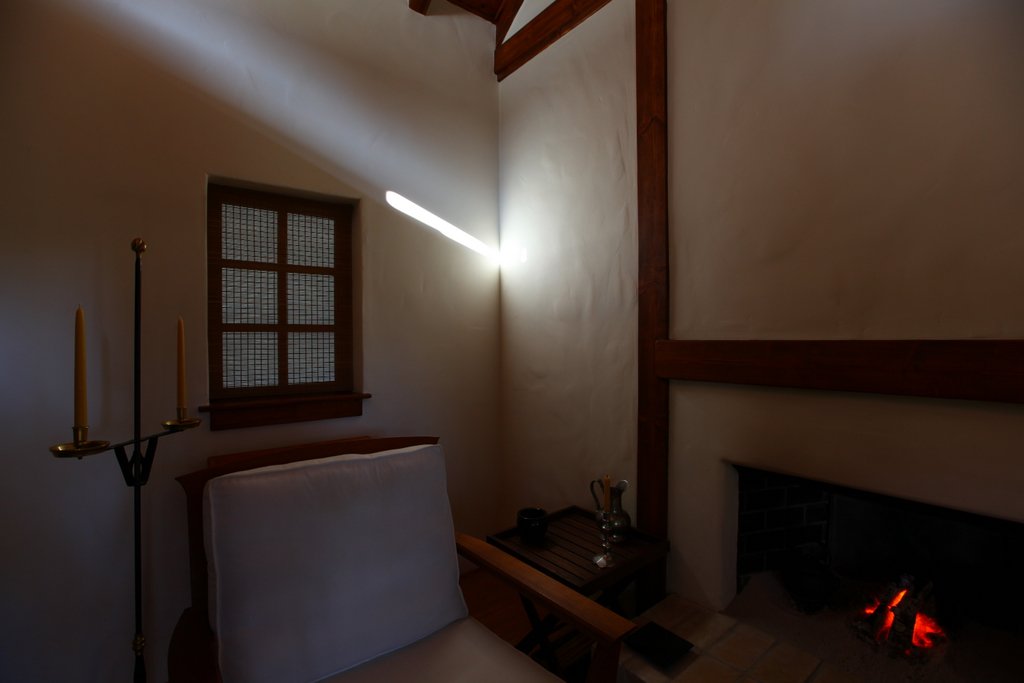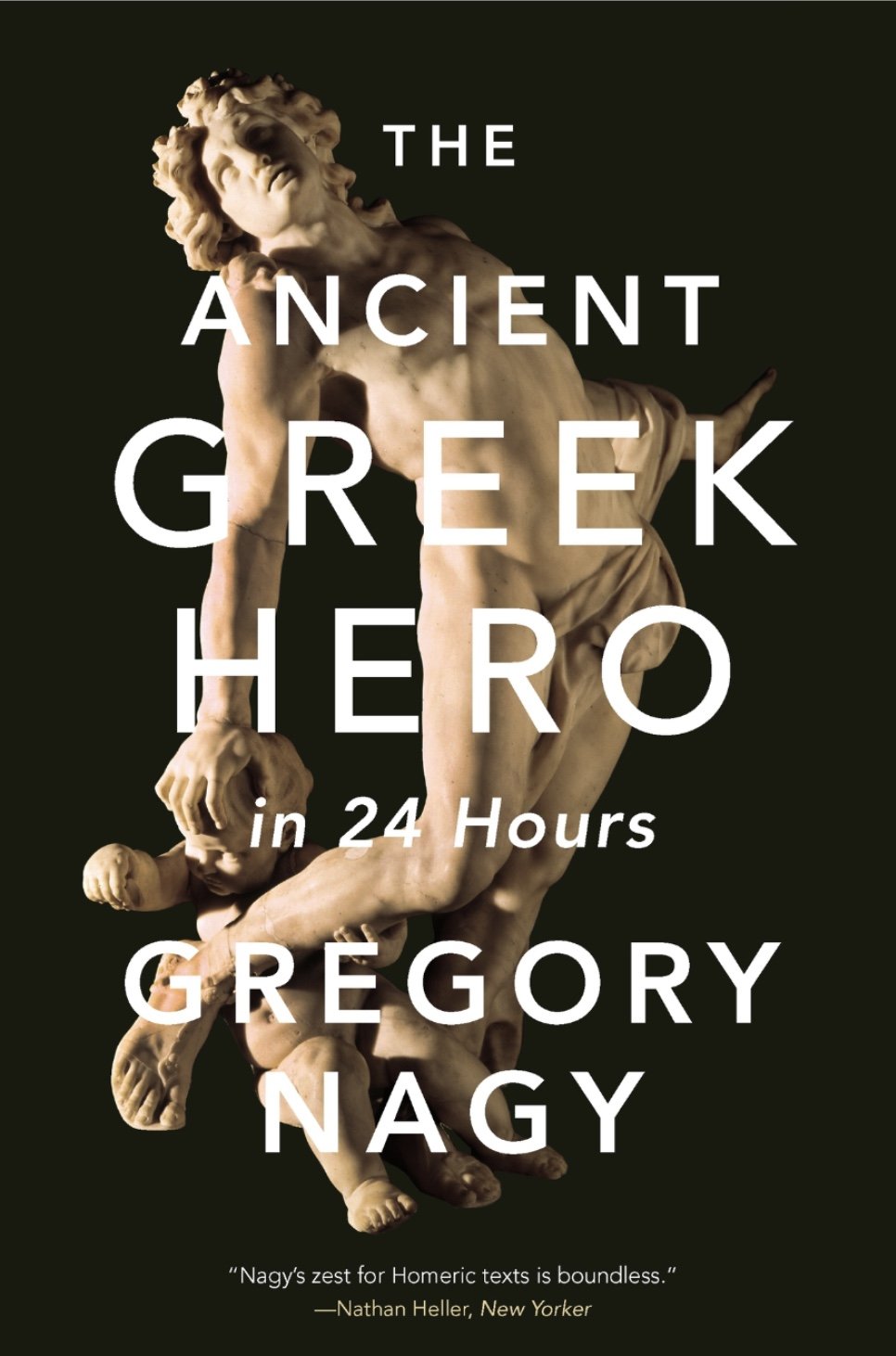Innermost House, Northeast Corner, Late Afternoon Light
In order to attain the impossible, one must attempt the absurd.
Miguel de Unamuno, Essays and Soliloquies
We have for a long time now lived in pursuit of the impossible. Or possibly it has been the absurd. I have never entirely known which where we are concerned. I only know from thirty years of experience that we live in pursuit of something irreducible to conventional categories, something that can only be defined as undefinable. Something like the sound of the wind in the trees. Something like the light of fire.
The emblem of the Innermost House Foundation is a squared circle enclosing an "IH" cipher representing a black house “H” centered upon a red fire “I”: Innermost House. The expression, "squaring the circle," has been used for centuries to suggest achieving the impossible. Dante uses the analogy in the closing lines of the Divine Comedy as he struggles impossibly to express the nature of Transcendent Reality.
The puzzle of squaring the circle was proposed by ancient geometers. It consists in the challenge of constructing a square with the same area as a given circle by using a finite number of steps with compass and straightedge, in the manner of the plain old geometry we learned at school.
To the relief of schoolchildren everywhere, in 1882 the task was demonstrated to be impossible. The Lindemann–Weierstrass theorem proved that pi (π) is a "transcendental" number: that is, that pi is for real all right, but it is neither rational nor algebraic. Therefore, approximate squaring is the best we can hope for in this fallen world.
It would be difficult to conjure a more fitting symbol for our work. The impossible we seek to accomplish is built into our very foundations, right down to our statement of mission. All we can say for certain is that ours is a Mission Impossible.
Christopher Wren Building, College of William & Mary, 1695
Our American Wisdom Project at William & Mary and our Virginia House Project with Colonial Williamsburg have lately brought us a new circle of students and readers, many of whom are naturally unfamiliar with the long search that led to this place in our Foundation’s work. For long-accustomed intimates of that journey, our proof is in the pudding, with no further explanation of purpose required. But with each new circle reached, we welcome the opportunity to give an account of ourselves, however hopelessly.
In the language of that wonderful story by Hawthorne, we are Artists of the Beautiful, the benefit of whose work, even if it fly to the ends of the earth, cannot be pragmatically defined. To know us over time is to allow our work to proceed loosely understood as an Art of Life lived in public, a kind of outward keeping of the inward fire, for the most ineffable things can too easily be defined right out of existence.
Now, that kind of transcendental talk may pass naturally enough with the transcendentalists among us. And perhaps it is natural enough that it should receive a warm reception at William & Mary and Colonial Williamsburg, for they are in many ways our locally and historically transcendental forebears. It even passes at the Registry of Charitable Trusts.
Only when we cross one of those unpredictable thresholds of new acquaintance where a password is required, do we newly cast about for something resembling a conventional statement of mission. Happily, we have a brilliantly articulate body of advisors and friends who are always delighted to take up the challenge from their own point of view. Last week I had occasion to look back over a few years of those statements as we feel our way yet again toward another Unstatement of Unmission.
The first goes back seven years. It is the draft statement we used in working documents before we were granted our 501c3 nonprofit status. Even now, it's not too bad:
The Innermost House Foundation is a nonprofit organization conceived as a living experiment in the transcendental strain of "plain living and high thinking" in American life. Our special mission is to influence thought culture and promote public awareness of the transcendental dimension in our laws and institutions, literature and arts, natural history and philosophy, spirituality and wilderness. This we propose to pursue through sponsored scholarship, published writings, film and photography, public speaking and conversation forums, employing both traditional and electronic media.
That essential phrase, “plain living and high thinking,” comes to us from Wordsworth by way of David Shi’s classic book on the history of the tradition we would represent, The Simple Life: Plain Living and High Thinking in American Culture. I suppose in all the world of historical scholarship, it is the one work we could least do without. Dr. David Shi is President Emeritus of Furman University, one of our leading American historians, and founding member of the Innermost House Foundation. As David tells the story, the ethic of plain living and high thinking has meant many things over the course of American history, but always it has represented the New World incarnation of an ancient and perennial idea: that wisdom consists in a wholeness of view, and that the essential-most of wholenesses is a oneness of nature and spirit, of earth and heaven, of body and mind, of archetype and ideal.
When our excellent attorney, young Ms. Casey Williams of the august old firm, Donahue Fitzgerald, set to redacting that statement for our Form 1023 application five years ago, it won for us our 501c3 status in record time:
The Innermost House Foundation is a California Nonprofit Public Benefit Corporation organized and operated for charitable, educational, and literary purposes. The specific purpose of the Foundation is to promote public awareness and appreciation of transcendental history, philosophy, poetry and practice, thus to renew the living spirit of transcendentalism by making its message immediate, relevant, and compelling to modern audiences.
Founding member of our Board of Directors, Mr. Christopher Nelson, is President Emeritus of St. John’s College in Annapolis, among our oldest colleges in this country and the leading representative of the classical curriculum in America today. When we first met, Chris told me that he understood “Innermost House” to be a name for the soul, akin to St. Teresa’s “Interior Castle” or Marcus Aurelius’s “Inner Citadel.” And what possible statement of worldly mission can be otherwise than impossibly remote from the soul?
To founding Advisor Dr. Gregory Nagy, longtime Chair of Classics at Harvard and Director of the Harvard Center for Hellenic Studies in Washington D.C., Innermost House is essentially a circle of philosophical Idealists. As the age’s leading authority on Homeric literature, celebrated teacher of the Ancient Greek Hero, and champion of the importance of Hellenic civilization to the modern world, one may suppose Greg to be in a perfect position to recognize classical Idealism when he sees it. Modern-day idealism is mostly identified by what it attempts to do or what it imagines may be done in the future, and naturally exercises itself with missions of reform. Classical Idealism, on the contrary, is distinguished by what it sees and is; it is less a condition of doing than of being. What can possibly be the mission of a circle of Idealists but to revolve continuously about a still center of Reason to the Music of the Spheres?
But something somehow must be said. Among the most active members of our Advisory Council is Dr. Robert Gross, Professor Emeritus of Early American History at the University of Connecticut and founding Director of the American Studies program at William & Mary. Last year Bob published his great work, The Transcendentalists and Their World, which I found so exciting that I read the whole book in one long sitting—all six hundred pages. It formed the principal reference for our recent course offering at William & Mary, “Walden, the Prophets, and the Nineteenth Century.” At regular intervals through the years, I have applied to Bob for at least some kind of mission statement, since we are at least some kind of 501c3. Not that anyone can say exactly what kind. Bob has never disappointed me. I no sooner ask but that he dashes off another brilliant draft to suit the occasion’s need, every one a perfect model of clarity and comprehensive detail:
The Innermost House Foundation is a nonprofit organization inspired by Henry David Thoreau’s experiment of life in the woods at Walden Pond in Concord, Massachusetts, from 1845 to 1847. We seek to promote conversation and culture through educational programs and to foster efforts to conserve the natural environment through sustainable projects in small-scale living. Our aim is to renew the quest for spirituality, wisdom, and harmony with nature that has inspired some of America’s best thinkers, in continuing engagement with traditions of thought and material culture extending from the Native peoples of the Americas to the classical hearths of Western civilization to the diverse philosophical and religious perspectives of Africa, the Middle East, the Indian Subcontinent and East Asia.
Along the way from the Foundation’s beginnings, there has also been the testimony of our hundreds of thousands of virtual media followers, particularly back when we had a Facebook page. We continually threaten to reopen that page, but ever again we choose to remain out of the social media fray. Here a long-time follower named Pam Kowal, a hospital administrator in Upstate New York, offered her spontaneous summary as a review in the ratings section on our Facebook page, which I still think eloquently expresses the experience of our readers there. We frequently receive letters expressing a similar sentiment:
Innermost House is a unique offering of love for people who are inspired to live authentic lives that embody the highest ideals of the human spirit. It provides daily inspiration and guidance from the greatest minds throughout history to encourage and support each participant as they investigate their personal relationship with the natural world of which we are each an inseparable part. Innermost House models what such a lifestyle is like in practical terms. Each part of the life there has been carefully selected to support the inner Presence in the 'timeless time' of the immediate moment. It brings to life a heartfelt awareness and a sense of wonder at the sacredness of life. It is truly an extraordinary opportunity to connect meaningfully with my own heart and to live an examined life in the online company of likeminded seekers.
I must say, that is still pretty great. There is nothing to gainsay, whatever else remains to be said.
Then there is my dear friend, Dr. James Mathew, a leading cardiologist in Minneapolis, lifetime reader of Henry Thoreau, and member of our Advisory Council. James was educated at the University of Kerala in India before establishing his practice in this country. If anyone may be said to possess the gift of what Mary Moody Emerson called "holy enthusiasm," it is he. James and I share an interest in the universalism of Swami Vivekananda, and in that connection he sent me an address by Bishop Paulos Gregorios of the Indian Orthodox Church on the "Spiritual Unity of the Human Race." The address might have served as an excellent statement of purpose for us, but—alas!—it was too long. Never to be discouraged, James suggested this in its place:
Inspired by the lives and teachings of Henry David Thoreau and Ralph Waldo Emerson, the Innermost House Foundation seeks to renew man's quest for spirituality and wisdom, and to promote life in harmony with nature and society through personal examples and educational programs.
Our corporate treasurer and philosopher-of-all-things-scientific, Mr. Bryce Engelbrecht, regularly lends his eloquence to the question. Bryce is a focused, technologically sophisticated and serious-minded sort of person, for whom fractal geometry and angles of repose are home territory. When I lately set him the task of speaking for our mission, on the moment he plucked this out of the blue sky as a meditative statement of purpose:
Innermost House stands for an idea that does not change. At the axis of a revolving and accelerating history, it stands for permanence, a position from which to see all in perspective, a place where the first and the last things, the natural and the ideal, meet. Our purpose is to plant a seed from which to grow a new point of view equal to the needs of our changing world.
George Wythe House, Williamsburg, 1750
Mr. John Gillis, our Foundation Chairman of the Board, is a self-made industrialist, great friend, and bone-deep man of principle. “Nothing can bring you peace but the triumph of principles”—that’s John by way of Mr. Emerson. A while ago John was jetting back from somewhere or other and had our website open on his laptop. The banker sitting next to him recognized a photograph of the George Wythe house in Williamsburg on one of our posts, and asked what the Foundation was about. John is a man of few words, and found himself explaining us in this way:
We are interested in the American thought tradition and the ways it unites and transforms the best thoughts of the wider world. Preserving that tradition seems to us the right custodial thing to do, so that all may be aided in thinking the thoughts that make for better and deeper lives.
Then there is a statement on our website homepage, which, if nothing else, has at least the virtue of brevity:
The Innermost House Foundation is a 501(c)(3) nonprofit organization that exists to provide a place apart, in the woods and on the web, where we each alone may find a home for wholeness.
Briefer still is a motto we sometimes use to represent the essence of our transcendental aspiration:
Feet on the ground, eyes on the stars.
Is that not really just plain living and high thinking? There have been many formulations from culture to culture and from time to time of what is essentially one idea.
Just for tonight, and in the light of last week’s explorations, I shall make my own wild try at a kind of statement. I do not think it will satisfy anyone. No doubt it is yet another one of my absurdities. But perhaps it begins to complete all other and better statements with what one only learns by trying to find a way through to a place beneath and before all thoughts of mission:
The Innermost House is a work of art and thought, set on the tragic stage of American history, recollecting a thousand older works and stages. It is an eye trained upon the place of first light, an ear turned toward the sounds that echo from the foundations of the world. It is a way of remembering.
Is there something—anything—that such a variety of statements can teach us? Our mission at the Innermost House Foundation has something historically to do with Emerson, Thoreau, Walden Pond, and Transcendentalism. It has something to do with the Ancient Greek Heroic Tradition. It has something to do with revolutionary Williamsburg and the wilderness West. It has something to do with spirituality and wisdom. It has something to do with inspiration and practice. It has something to do with the ground beneath our feet, with the stars over our heads, and the woods around our memories.
California House I, Southeast Window, Wild Sage








